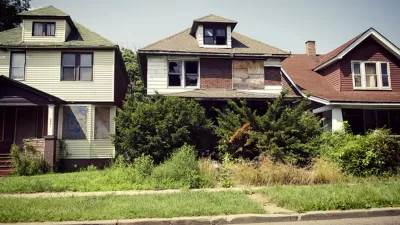A new report uses terms like epidemic and hyper-vacancy to drive home the point about the effects of vacancies on communities like Cleveland, Gary, Toledo, and Detroit.

Patrick Sisson shares insights into a new report from the Lincoln Institute of Land Policy titled "The Empty House Next Door." The report examines "abandoned and unused properties [and] offers a deft accounting of the cost of these buildings on the surrounding areas."
"Compiled by urban scholar Alan Mallach, the report offers a sobering snapshot of just how widespread vacancy has become, especially in the aftermath of the Great Recession," writes Sisson.
Vacant properties aren’t new. According to Mallach, the roots of today’s problem lie in the Great Recession and subsequent foreclosure crisis, in which many homeowners, especially lower-income residents, lost their homes. Combined with the declining population in legacy cities, vacancies have skyrocketed.
The article includes a lot more detail on the research used to build the report's conclusions. Alan Mallach also authored a new book on related subjects, The Divided City, published this month by Island Press.
FULL STORY: The high cost of abandoned property, and how cities can push back

Alabama: Trump Terminates Settlements for Black Communities Harmed By Raw Sewage
Trump deemed the landmark civil rights agreement “illegal DEI and environmental justice policy.”

Study: Maui’s Plan to Convert Vacation Rentals to Long-Term Housing Could Cause Nearly $1 Billion Economic Loss
The plan would reduce visitor accommodation by 25% resulting in 1,900 jobs lost.

Why Should We Subsidize Public Transportation?
Many public transit agencies face financial stress due to rising costs, declining fare revenue, and declining subsidies. Transit advocates must provide a strong business case for increasing public transit funding.

Paris Bike Boom Leads to Steep Drop in Air Pollution
The French city’s air quality has improved dramatically in the past 20 years, coinciding with a growth in cycling.

Why Housing Costs More to Build in California Than in Texas
Hard costs like labor and materials combined with ‘soft’ costs such as permitting make building in the San Francisco Bay Area almost three times as costly as in Texas cities.

San Diego County Sees a Rise in Urban Coyotes
San Diego County experiences a rise in urban coyotes, as sightings become prevalent throughout its urban neighbourhoods and surrounding areas.
Urban Design for Planners 1: Software Tools
This six-course series explores essential urban design concepts using open source software and equips planners with the tools they need to participate fully in the urban design process.
Planning for Universal Design
Learn the tools for implementing Universal Design in planning regulations.
Smith Gee Studio
Alamo Area Metropolitan Planning Organization
City of Santa Clarita
Institute for Housing and Urban Development Studies (IHS)
City of Grandview
Harvard GSD Executive Education
Toledo-Lucas County Plan Commissions
Salt Lake City
NYU Wagner Graduate School of Public Service





























